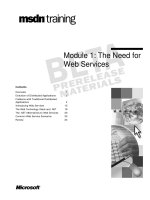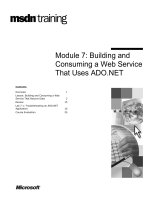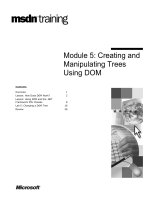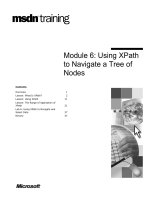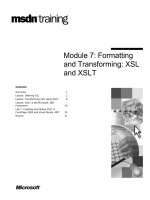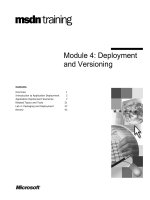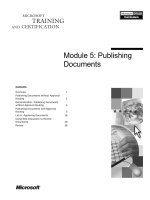Tài liệu Module 6: Publishing and Deploying Web Services pptx
Bạn đang xem bản rút gọn của tài liệu. Xem và tải ngay bản đầy đủ của tài liệu tại đây (722.93 KB, 42 trang )
Contents
Overview 1
Overview of UDDI 2
Publishing a Web Service 17
Finding a Web Service 20
Publishing a Web Service on an Intranet 22
Configuring a Web Service 24
Lab 6: Publishing and Finding Web
Services in a UDDI Registry 27
Review 38
Module 6: Publishing
and Deploying Web
Services
Information in this document, including URL and other Internet Web site references, is subject to
change without notice. Unless otherwise noted, the example companies, organizations, products,
domain names, e-mail addresses, logos, people, places, and events depicted herein are fictitious,
and no association with any real company, organization, product, domain name, e-mail address,
logo, person, places or events is intended or should be inferred. Complying with all applicable
copyright laws is the responsibility of the user. Without limiting the rights under copyright, no
part of this document may be reproduced, stored in or introduced into a retrieval system, or
transmitted in any form or by any means (electronic, mechanical, photocopying, recording, or
otherwise), or for any purpose, without the express written permission of Microsoft Corporation.
Microsoft may have patents, patent applications, trademarks, copyrights, or other intellectual
property rights covering subject matter in this document. Except as expressly provided in any
written license agreement from Microsoft, the furnishing of this document does not give you any
license to these patents, trademarks, copyrights, or other intellectual property.
2001 Microsoft Corporation. All rights reserved.
Microsoft, MS-DOS, Windows, Windows NT, Active Directory, Authenticode, Biztalk,
Intellisense, Jscript, MSDN, PowerPoint, Visual Basic, Visual C++, Visual C#, Visual Studio,
Win32, and Windows Media are either registered trademarks or trademarks of Microsoft
Corporation in the U.S.A. and/or other countries.
The names of actual companies and products mentioned herein may be the trademarks of their
respective owners.
Module 6: Publishing and Deploying Web Services iii
Instructor Notes
This module teaches students how to publish Web Services and locate Web
Services using the Microsoft
®
Universal Description, Discovery, and
Integration (UDDI) software development kit (SDK). A local development
UDDI registry is used in the demonstrations and lab for this module, but the
mechanics of publishing and finding Web Services is no different on the public
UDDI registry nodes.
After completing this module, students will be able to:
!
Explain the role of UDDI in Web Services.
!
Publish a Web Service in a UDDI registry using the Microsoft UDDI
software development kit (SDK).
!
Search a UDDI registry to locate Web Services by using the UDDI SDK.
!
Explain the various options for publishing a Web Service on an intranet.
!
Explain some of the options for modifying the default configuration of a
Web Service.
Materials and Preparation
This section provides the materials and preparation tasks that you need to teach
this module.
Required Materials
To teach this module, you need the Microsoft PowerPoint
®
file 2524A_06.ppt.
Preparation Tasks
To prepare for this module:
!
Read all of the materials for this module.
!
Practice all of the demonstrations.
!
Review the walkthrough demo code in <install folder>\Democode\Mod06.
!
Complete the lab.
Presentation:
90 Minutes
Lab:
60 Minutes
iv Module 6: Publishing and Deploying Web Services
Module Strategy
Use the following strategy to present this module:
!
Overview of UDDI
This topic provides and overview of the role of UDDI registries in the
process of Web Service discovery. The UDDI data structures and
application programming interfaces (APIs) are explained. Ensure that you
cover each of the elements in the UDDI data structure and describe how
they are used. Many students might have difficulty understanding the
tModel element. Explain that the tModel element is deliberately generically
defined because it can be used in multiple ways in UDDI. Explain that using
tModel to represent Web Services Description Language (WSDL)
documents is just one of its uses. Provide only a brief overview of publisher
assertions. Explain the publisher and inquiry APIs. Emphasize that each of
these APIs is a Web Service operation that can be invoked using Simple
Object Access Protocol (SOAP). Explain how the UDDI SDK encapsulates
these operations.
!
Publishing a Web Service
Explain how to publish tModels and business entities. Emphasize that
tModels are not explicitly associated with business entities. Therefore,
before publishing a business service, you must publish the necessary
business entities and tModels. Explain how to publish a binding template
and also explain the importance of binding templates in locating the
endpoints for Web Services.
!
Finding a Web Service
Explain how to locate binding information for a Web Service using the
UDDI SDK. Emphasize that at the moment there no standards for how Web
Services should be published and how the information that is published
about a Web Service should be used to locate the Web Service. Explain to
the students that they will not be able to locate endpoints for all Web
Services programmatically.
!
Publishing a Web Service on an Intranet
Explain the issues involved in deploying a Web Service on an Intranet from
the perspective of publishing and finding Web Services. This topic explains
some of the options that are available for publishing a Web Service on an
intranet in the absence of a commercial private UDDI registry.
!
Configuring a Web Service
This topic focuses on the issues specific to the assemblies that make up a
Web Service. The topic covers modifying the default discovery behavior,
configuring assembly settings, security considerations, and localization of
assemblies. Use this topic to introduce students to topics such as
localizations and building and deploying satellite assemblies, which are
beyond the scope of this course, and yet applicable to Web Services.
Module 6: Publishing and Deploying Web Services 1
Overview
!
Overview of UDDI
!
Publishing a Web Service
!
Finding a Web Service
!
Publishing a Web Service on an Intranet
!
Configuring a Web Service
*****************************
ILLEGAL FOR NON
-
TRAINER USE
******************************
Module 4, “Consuming Web Services,” in Course 2524A, Developing XML
Web Services Using Microsoft Visual C# .NET Beta 2 explains locating Web
Services discovery documents at known endpoints (network locations). You can
locate Web Services at unknown endpoints by using a public registry of Web
Services. Universal Description, Discovery, and Integration (UDDI) registries
facilitate service discovery on the Web.
After completing this module, you will be able to:
!
Explain the role of UDDI in Web Services.
!
Publish a Web Service in a UDDI registry using the Microsoft
®
UDDI
software development kit (SDK).
!
Search a UDDI registry to locate Web Services by using the UDDI SDK.
!
Explain the various options for publishing a Web Service on an intranet.
!
Explain some of the options for modifying the default configuration of a
Web Service.
Topic Objective
To provide an overview of
the module topics and
objectives.
Lead-in
In Module 4, “Consuming
Web Services,” in Course
2524A, Developing XML
Web Services Using
Microsoft Visual C# .NET
Beta 2, you learned about
locating Web Services
discovery documents at
known endpoints.
2 Module 6: Publishing and Deploying Web Services
"
""
"
Overview of UDDI
!
What Is UDDI?
!
UDDI Data Structures
!
Demonstration: Using UDDI Explorer
!
UDDI Programmer's API
*****************************
ILLEGAL FOR NON
-
TRAINER USE
******************************
The role of a Web Service broker is essential in Web Services architecture to
make it possible for potential consumers to easily find a Web Service. UDDI
registries fulfill the role of a Web Service broker. In this section, you will learn
about UDDI and its specifications.
Topic Objective
To introduce the topics in
this section.
Lead-in
The role of a Web Service
broker is essential in Web
Services architecture to
make it possible for potential
consumers to easily find a
Web Service.
Module 6: Publishing and Deploying Web Services 3
What Is UDDI?
!
A Collection of Specifications
#
Specifications for distributed Web-based information
registries of Web Services
- UDDI Programmer’s Specification
- UDDI Data Structure Specification
!
UDDI Registry Implementations
#
Implementations of the specifications
*****************************
ILLEGAL FOR NON
-
TRAINER USE
******************************
Before learning how to programmatically publish and discover Web Services, it
is important to understand the functions of UDDI from a programmer’s
perspective.
A Collection of Specifications
Universal Description, Discovery, and Integration (UDDI) is a collection of
specifications for distributed Web-based information registries of Web
Services. These specifications are broken down into a number of categories.
The UDDI Programmer’s application programming interface (API)
Specification and the UDDI Data Structure Specification are of specific interest
to a Web Service developer. The current versions of these specifications can be
found at .
All of the information about the UDDI Programmer’s API and UDDI
Data Structure specifications is based on version 2.0 of the specifications.
The UDDI Programmer’s API Specification
The UDDI Programmer’s API defines functions that provide a simple
request/response model for accessing UDDI registries. There are two types of
API defined in the API reference:
!
A publisher API that allows you to publish data in a registry.
!
An inquiry API that allows you to read information from a registry.
The Programmers’ API specification defines approximately 40 Simple Object
Access Protocol (SOAP) messages that are used to query for information and
publish functions in any UDDI-compliant service registry.
Topic Objective
To describe UDDI and its
specifications.
Lead-in
Before learning how to
programmatically publish
and discover Web Services,
it is important to understand
the functions of UDDI from a
programmer’s perspective.
Note
4 Module 6: Publishing and Deploying Web Services
The UDDI Data Structure Specification
The UDDI Data Structure Specification outlines the details of each of the
Extensible Markup Language (XML) structures associated with the messages
defined in the Programmer’s API Specification.
UDDI Registry Implementations
UDDI is also a set of implementations of the specifications that allow
businesses to register information about the Web Services that they offer so that
other businesses can find them. These implementations are publicly accessible.
Also, UDDI registries are themselves available as Web Services.
At the time of this writing, there are two public implementations of these
specifications. They can be located at and
Multiple root UDDI nodes (network nodes or computers that host UDDI
registries) provide a logically unified, but physically distributed and replicated
information store for Web Services metadata (service descriptions, etc.).
UDDI can provide answers to queries such as:
!
What Web Services does a specific business provide?
!
What are all the known endpoints for a specific Web Service?
!
What is the current binding information (supported protocols, etc.) for a
specific Web Service endpoint?
Other possible queries, such as price comparison of Web Services or
geographic proximity, are not part of the UDDI specification. Currently, such
additional queries and associated metadata are considered value-added services
that vendors are free to implement and offer.
Module 6: Publishing and Deploying Web Services 5
UDDI Data Structures
businessService: Descriptive
information about a particular service.
publisherAssertion: Information
about a relationship between two
parties, asserted by both of them.
tModel: Descriptions of specifications
for services or taxonomies. Basis for
technical fingerprints.
bindingTemplate: Technical
Information about a service entry
point.
businessEntity: Information about
the party who publishes information
about a family of services.
*****************************
ILLEGAL FOR NON
-
TRAINER USE
******************************
The UDDI Data Structure Specification defines the XML schema that is used to
describe types in UDDI. The specification defines five data types:
!
businessEntity
!
businessService
!
bindingTemplate
!
tModel
!
publisherAssertion
The preceding data structures are defined using the XML Schema Definition
Language (XSD). Let us examine each of the data structures.
The businessEntity Element
The businessEntity element describes a business or an entity that has registered
a Web Service within UDDI. The businessEntity is the top-level element that
contains descriptive information about a business or an entity. This element
supports standard information such as name, description, and contacts, as well
as metadata information such as identifiers and categories. The latter
information is used for standard taxonomies of business identifiers (tax
identifiers, D-U-N-S numbers, etc.) and categories (industry codes, geography
codes, etc.). Service descriptions and technical information are related to a
businessEntity by using containment.
D-U-N-S numbers are 9 digit numbers that are used as unique company
identifiers, by most companies around the world. They are issued by a company
named Dun & Bradstreet.
Topic Objective
To explain the main data
structures defined by the
UDDI specifications, and
how they relate to each
other.
Lead-in
The UDDI Data Structure
Specification defines the
XML schema that is used to
describe types in UDDI.
Delivery Tip
Explain the code for
registering the
businessEntity element
using the file <install
folder>\Democode\Mod06\
businessEntity.txt.
Note
6 Module 6: Publishing and Deploying Web Services
The following XML code shows a document that can be used to register a
businessEntity:
<businessEntity !
businessKey="434554F4-6E17-1342-EA4136E642531DA0"!
operator="">
<name>Contoso Micropayments</name>
<description xml:lang="en">
The Contoso Micropayment Service
</description>
<contacts>
<contact>
<description xml:lang="en">
Website Administrator
</description>
<personName>Jeff Smith</personName>
<phone>800-555-1212</phone>
<email></email>
<address>
<addressLine>1 Microsoft Way</addressLine>
<addressLine>Redmond, WA</addressLine>
</address>
</contact>
</contacts>
</businessEntity>
Module 6: Publishing and Deploying Web Services 7
The businessService Element
The businessService element describes a Web Service that is exposed by a
business entity. This element supports naming a Web Service and associating it
with a business entity and binding information. It also supports the assignment
of categories (industry, product, geographic codes, etc.) to the Web Service.
The following XML code shows a document that can be used to register a
businessService:
<businessService !
businessKey="434554F4-6E17-1342-EA41-36E642531DA0"!
serviceKey="AEAC8990-2891-3894-DEC1-AEF97501DD1B">
<name>Business Service example</name>
<description xml:lang="en">
description goes here
</description>
<bindingTemplates>
<!-- zero or more binding templates -->
<bindingTemplate>
elements go here…
</bindingTemplates>
</businessService>
The bindingTemplate Element
The bindingTemplate element describes the technical information necessary
for binding to a particular Web Service. This element supports naming a Web
Service and associating it with a business entity and binding information. The
binding information is described as either an access point or a hosting
redirector.
The accessPoint element
The accessPoint element describes a Web Service entry point. The accessPoint
element has an attribute named URLType, which is used to specify one of the
seven entry point types described in the following table.
Entry point types Descriptions
mailto The access point is an e-mail address.
http The access point is an Hypertext Transfer
Protocol (HTTP) compatible URL.
https The access point is an HTTP Secure
(HTTPS) compatible URL.
ftp The access point is a File Transfer
Protocol (FTP) directory address URL.
Fax The access point is a telephone number
that is answered by a fax machine.
Delivery Tip
Explain the code for
registering the
businessService element
using the file <install
folder>\Democode\Mod06\
businessService.txt.
Delivery Tip
Explain the code for
registering the
bindingTemplate element
using the file <install
folder>\Democode\Mod06\
bindingTemplate.txt.
8 Module 6: Publishing and Deploying Web Services
(continued)
Entry point types Descriptions
Phone The access point is a telephone number
that is answered by a human or voice
response system.
Other The access point is any format other than
the preceding ones. When this URL type
is specified, the specification information
(in the tModel element) must indicate a
transport type.
The hostRedirectory element
Alternatively, the hostRedirectory element can be used in the absence of the
accessPoint element to point to another bindingTemplate for specific binding
information. The hostRedirectory element is also used to provide a mechanism
to allow multiple binding templates to be associated with a single Web Service.
The following XML code shows a document that can be used to register a
bindingTemplate:
<bindingTemplate !
bindingKey="FE542889-EE4B-2348-2345-AEFC3901223A"!
serviceKey="AEAC8990-2891-3894-DEC1-AEF97501DD1B">
<description xml:lang="en">
Micropayments binding template
</description>
<accessPoint URLType="http">
</accessPoint>
<tModelInstanceDetails>
<!-- ...zero or more -->
<tModelInstanceInfo>
elements go here
</tModelInstanceDetails>
</bindingTemplate>
Module 6: Publishing and Deploying Web Services 9
The tModelInstanceDetails element
A bindingTemplate also contains a tModelInstanceDetails element. The
tModelInstanceDetails element contains an unordered list of tModelKey
references. This list of references forms a unique fingerprint. For example, if
there are two business services where each of them referenced three tModels,
but only two of the three tModels references are the same for each service, then
the two services have different fingerprints. When a bindingTemplate is
registered within a businessEntity structure, it will contain one or more
references to a specific set of specifications. The identity of these specifications
is indicated by the tModelKey values provided with the registration.
During an inquiry for a service, the information contained in the specifications
that are referred to when a bindingTemplate is registered can later be used to
locate a specific bindingTemplate that contains a particular tModel reference
or set of tModel references. By listing a tModelKey reference in a
bindingTemplate, a Web Service containing this bindingTemplate claims to
be compatible with the specifications implied by the tModelKey.
Within a tModelInstanceDetails element is a list of zero or more
tModelInstanceInfo elements. Each tModelInstanceInfo has an attribute
named tModelKey which identifies a specific tModel. A tModelInstanceInfo
element also has a description, a reference to an overview document, and
instance parameters. The optional overview document contains a URL for
locating the entry point specification document. The instance parameters
contain either XML or a URL to an XML document that contains parameter
setting information.
The following XML code shows an example of a tModelInstanceInfo element
within a tModelInstanceDetails:
<tModelInstanceInfo !
tModelKey="uuid:E31A569A-AEFF-4468-BA4D-2BF22FE4ACEE">
<description xml:lang="en">
Micropayments tModel
</description>
<instanceDetails>
<description xml:lang="en">
Micropayment instance details description
</description>
<overviewDoc>
<description xml:lang="en">
Micropayment Service Overview
</description>
<overviewURL>
micropayments/overview.aspx
</overviewURL>
</overviewDoc>
<instanceParms>
micropayments/params.aspx
</instanceParms>
</instanceDetails>
</tModelInstanceInfo>
Delivery Tip
Explain the example code
for a tModelInstanceInfo
element in a
tModelInstanceDetails
element, using the file
<install
folder>\Democode\Mod06\
tModelInstanceInfo.txt.
10 Module 6: Publishing and Deploying Web Services
The tModel Element
One of the most important goals of UDDI is to provide a facility to make Web
Service descriptions rich enough so that one can easily learn how to interact
with a service that one did not know much about. To accomplish this goal, there
must be a way to attach metadata to a description of a Web Service. This
metadata can be used in a variety of ways. For example, the metadata can
define how the Web Service behaves, what conventions it follows, or what
specifications or standards it is compliant with. The tModel element provides
the ability to describe compliance with a specification, concept, or even a
shared design.
The structure of a tModel element takes the form of metadata with a unique
keyed data. Although a tModel registration can define almost anything,
currently there are two primary ways to use tModel elements:
!
To determine if two Web Services are compatible.
!
To provide keyed namespace references.
The information that makes up a tModel is quite simple. There’s a key, a name,
an optional description, and a URL that indicates where more information about
the Web Service can be found. Also, because tModels can be referenced by
many different business entities, the same Web Service interface may be
implemented by multiple business entities.
If a tModel represents a Web Services Description Language
(
WSDL)
document, then the categoryBag element of the tModel structure should
contain a keyedReference element. The keyName attribute of the
keyedReference element should have the value uddi-org:types, and the
keyValue attribute should have the value wsdlSpec. Also the overviewURL
element in the overviewDoc element should contain the location of the WSDL
document.
The following XML code shows a document that can be used to register a
tModel:
<tModel tModelKey="uuid:455655B7-4C43-4f3e-BB0B-695FE2120C53">
<name>Micropayment tModel</name>
<description xml:lang="en">
WSDL Description for a micropayment web service
</description>
<overviewDoc>
<description xml:lang="en">
The micropayment web service tModel
</description>
<overviewURL>
http://localhost/Contoso/overview.htm
</overviewURL>
</overviewDoc>
<categoryBag>
<keyedReference tModelKey="uuid:C1ACF26D-9672-4404-9D70-
39B756E62AB4"
keyName="uddi-org:types"
keyValue="wsdlSpec"/>
</categoryBag>
</tModel>
Delivery Tip
Explain the code for
registering the tModel
element using the file
<install
folder>\Democode\Mod06\
tModel.txt.
Module 6: Publishing and Deploying Web Services 11
The publisherAssertion Element
Many large organizations may not be effectively represented by a single
businessEntity, because there might be many ways to categorize them or the
services they offer. As a result, such organizations might publish several
businessEntity structures. However, these business entities are still related and
at least some of their relationships should be visible in their UDDI registrations.
Therefore, two related businesses use the set_publisherAssertions message to
publish assertions of business relationships.
To eliminate the possibility that one publisher claims a relationship between
two businesses that is, in fact, not reciprocally recognized, each publisher must
agree that the relationship is valid by publishing their own publisherAssertion.
Both publishers have to publish exactly the same information. When this
happens, the relationship becomes visible.
In this example, the businessEntity with the businessKey value of “1234-...” is
the parent holding company of the businessEntity with the businessKey value
of “4567-...”.
<publisherAssertion>
<fromKey>1234-....</fromKey>
<toKey>4567-....</toKey>
<keyedReference tModelKey="uuid:1357..." !
keyName="Holding Company" keyValue="parent-child">
</publisherAssertion>
Delivery Tip
Explain the code for
registering the
publisherAssertion
element using the file
<install
folder>\Democode\Mod06\
publisherAssertion.txt.
12 Module 6: Publishing and Deploying Web Services
Demonstration: Using UDDI Explorer
*****************************
ILLEGAL FOR NON
-
TRAINER USE
******************************
In this demonstration, you will see how you can explore and manipulate UDDI
registries using UDDI Explorer.
UDDI Explorer is one of the sample applications that ship with the UDDI
SDK.
!
To locate information about a business using its name
1. Open UDDI Explorer (UDDIExplorer.exe) from the following folder
<install folder>\Democode\Mod06.
2. In the combo box, click
3. In the Name box, type Microsoft
4. Click Search.
5. Expand the nodes in the resulting tree.
!
To locate information about a tModel using its name
1. Select the tModels option.
2. In the Name box, type Microsoft
3. Click Search.
4. Expand some of the nodes in the resulting tree.
Topic Objective
To demonstrate the
structure of UDDI
registration information.
Lead-in
In this demonstration, you
will see how you can
explore and manipulate
UDDI registries using UDDI
Explorer.
Note
Delivery Tip
If you do not have Internet
access from the classroom,
you can register a few
businesses and tModels on
the instructor machine and
use those in the
demonstration.
